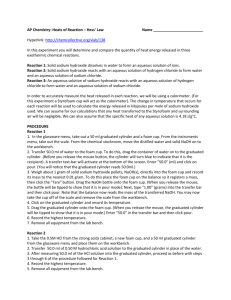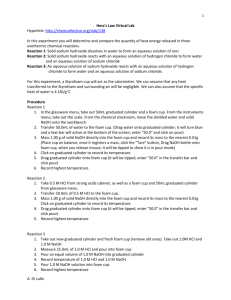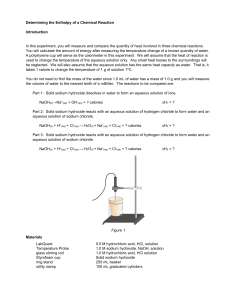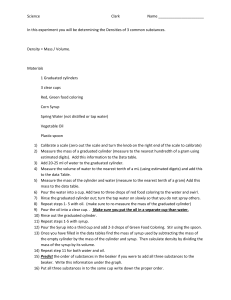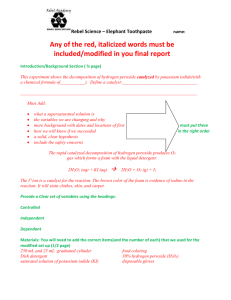Assignment
advertisement
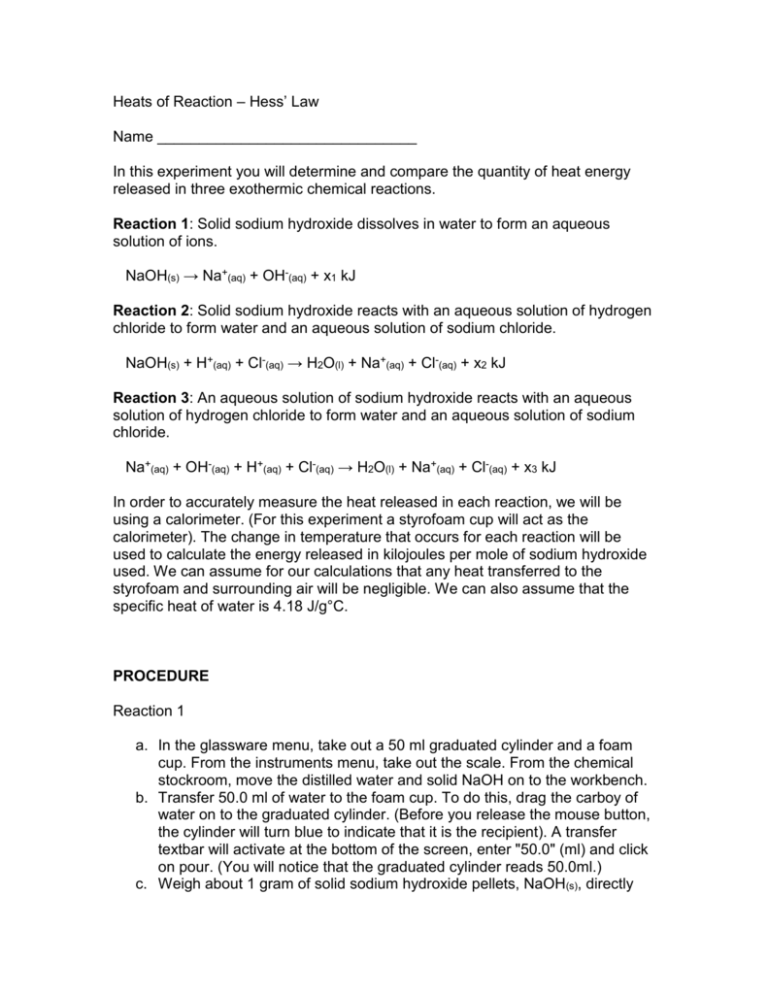
Heats of Reaction – Hess’ Law Name _______________________________ In this experiment you will determine and compare the quantity of heat energy released in three exothermic chemical reactions. Reaction 1: Solid sodium hydroxide dissolves in water to form an aqueous solution of ions. NaOH(s) → Na+(aq) + OH-(aq) + x1 kJ Reaction 2: Solid sodium hydroxide reacts with an aqueous solution of hydrogen chloride to form water and an aqueous solution of sodium chloride. NaOH(s) + H+(aq) + Cl-(aq) → H2O(l) + Na+(aq) + Cl-(aq) + x2 kJ Reaction 3: An aqueous solution of sodium hydroxide reacts with an aqueous solution of hydrogen chloride to form water and an aqueous solution of sodium chloride. Na+(aq) + OH-(aq) + H+(aq) + Cl-(aq) → H2O(l) + Na+(aq) + Cl-(aq) + x3 kJ In order to accurately measure the heat released in each reaction, we will be using a calorimeter. (For this experiment a styrofoam cup will act as the calorimeter). The change in temperature that occurs for each reaction will be used to calculate the energy released in kilojoules per mole of sodium hydroxide used. We can assume for our calculations that any heat transferred to the styrofoam and surrounding air will be negligible. We can also assume that the specific heat of water is 4.18 J/g°C. PROCEDURE Reaction 1 a. In the glassware menu, take out a 50 ml graduated cylinder and a foam cup. From the instruments menu, take out the scale. From the chemical stockroom, move the distilled water and solid NaOH on to the workbench. b. Transfer 50.0 ml of water to the foam cup. To do this, drag the carboy of water on to the graduated cylinder. (Before you release the mouse button, the cylinder will turn blue to indicate that it is the recipient). A transfer textbar will activate at the bottom of the screen, enter "50.0" (ml) and click on pour. (You will notice that the graduated cylinder reads 50.0ml.) c. Weigh about 1 gram of solid sodium hydroxide pellets, NaOH(s), directly into the foam cup and record its mass to the nearest 0.01 gram. To do this place the foam cup on the balance so it registers a mass, then click the "Tare" button. Drag the NaOH bottle onto the foam cup. (When you release the mouse, the bottle will be tipped to show that it is in pour mode). Next, type "1.00" (grams) into the transfer bar and then click pour. Note that the balance now reads the mass of the transferred NaOH. You may now take the cup off of the scale and remove the scale from the workbench. d. Click on the graduated cylinder, record its temperature and then drag it onto the foam cup. (When you release the mouse, the graduated cylinder will be tipped to show that it is in pour mode.) Enter "50.0" in the transfer bar and then click pour. Record the highest temperature. Reaction 2 a. Take the 0.5M HCl from the strong acids cabinet and a foam cup and 50 ml graduated cylinder from the glassware menu and place them on the workbench. The procedure for Reaction 2 is the same as for Reaction 1 except that 50.0 ml of 0.50 M hydrochloric acid solution is used in place of the water. After measuring 50.0 ml of the HCl solution into the graduated cylinder, proceed as before with steps b through d of the procedure. Reaction 3 a. Take out another graduated cylinder, a fresh foam cup, the 1.0 M HCl and the 1.0 M NaOH. (If you are running out of room, you may remove the previous chemicals.) Measure 25.0 ml of 1.0 M hydrochloric acid solution into the foam cup. Pour an equal volume of 1.0 M sodium hydroxide solution in the clean graduated cylinder. b. Record the temperature of each solution to the nearest 0.1°C. Pour the sodium hydroxide solution into the foam cup and record the highest temperature obtained during the reaction. PROCESSING THE DATA 1. Prepare a table with the following headings: Reaction, Mass of NaOH, Initial Temperature, Final Temperature, Heat Energy Released, Moles of NaOH and Molar Heat of Reaction. Next, create a row for each reaction. Complete the table using your collected information and any needed calculations. 2. Write the net ionic equations for Reactions 1, 2 and 3. Consider the heat given off in your reactions; add variables to your equations to represent heat evolved in kJ/mole. Use x1 for Reaction 1, x2 for Reaction 2, and x3 for Reaction 3 (as written above). 3. The energy, x1, in Reaction 1 represents the energy of solution for one mole of NaOH(s). Look at the net ionic equations for Reactions 2 and 3, and make a similar statement concerning the significance of x2 and x3. 4. Find the difference between the value of x2 and the sum of x1 plus x3. Account for any similarity or difference. 5. Calculate the percent difference between x2 and the sum of x1 and x3. (Assume x2 to be correct.) 6. Suppose you had used 4.00 grams of NaOH(s) in Reaction 1. What would have been the number of Joules released in the reaction? What effect would this have on the value of x1? DISCUSSION 1. Provide an explanation of the results collected above. 2. Look up Hess' Law and discuss how this experiment is an illustration. 3. If you were to repeat this experiment in the "real world", what are some of the major sources of error that could occur? CONCLUSION 1. Write a single statement that addresses what you learned in relation to your purpose or objective of this experiment.
